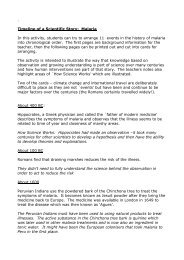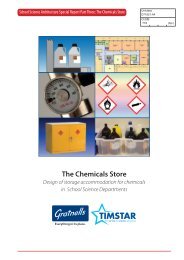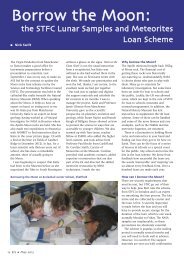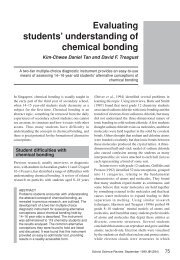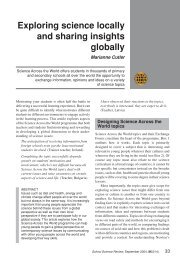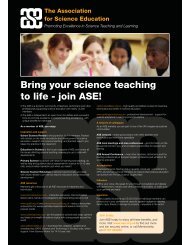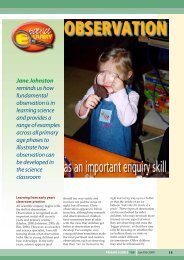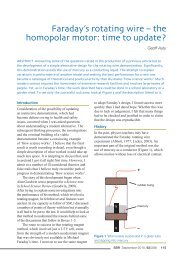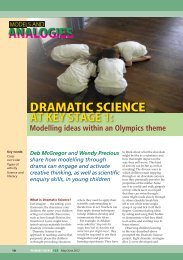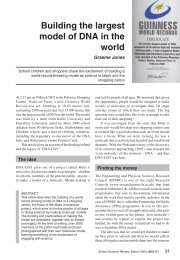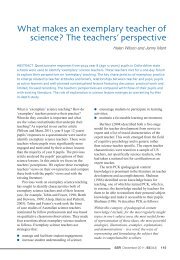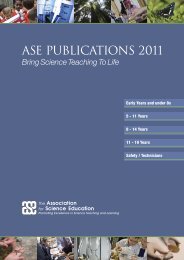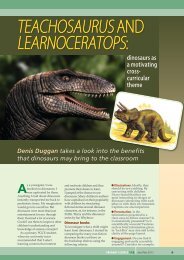Stuck for words - The Association for Science Education
Stuck for words - The Association for Science Education
Stuck for words - The Association for Science Education
You also want an ePaper? Increase the reach of your titles
YUMPU automatically turns print PDFs into web optimized ePapers that Google loves.
Children’s<br />
gestures<br />
can help us<br />
understand<br />
their ideas<br />
as Carol<br />
Callinan<br />
and John<br />
Sharp<br />
explain<br />
STUCK<br />
FOR WORDS<br />
Figure 1 What do<br />
children’s gestures<br />
tell us<br />
How many of you reading<br />
this now have seen<br />
children pausing, sitting<br />
back, sighing, waving their arms<br />
around and generally appearing<br />
to be stuck <strong>for</strong> <strong>words</strong> Have you<br />
stopped to ask yourself what this<br />
means What are children trying to<br />
tell us when they can’t find the <strong>words</strong><br />
that they need Children’s gestures<br />
are valuable in in<strong>for</strong>ming teaching<br />
practice and how we go about<br />
assessing children’s work in science.<br />
<strong>The</strong> importance of children’s<br />
errors, misconceptions and<br />
preconceptions in science<br />
education has become well<br />
established through a wide<br />
body of research conducted<br />
since the 1970s (<strong>for</strong> example see<br />
Vosniadou, 2008, <strong>for</strong> a recent<br />
review). In the UK, the highly<br />
influential Children’s Learning<br />
In <strong>Science</strong> (CLIS, 1987) and<br />
<strong>Science</strong> Processes and Concept<br />
Exploration (SPACE, 1989–1998)<br />
projects reminded us not only<br />
that children’s ideas often differ<br />
from those of scientists or what<br />
is taught in school, but that<br />
these can strongly influence<br />
the direction of future learning.<br />
Popular authors including<br />
Driver, Osborne and Harlen<br />
(Hodson, 1998), to name but a<br />
few, have all significantly helped<br />
to progress our understanding of<br />
how children learn science inside<br />
and outside the classroom. This<br />
in turn has highlighted the need<br />
to consider carefully not only<br />
what we teach but also how we<br />
teach it and when.<br />
Gestures and children’s<br />
ideas<br />
CLIS and SPACE focused on<br />
collecting children’s ideas using<br />
mainly interview techniques<br />
combined with drawings and<br />
concept maps. Subsequently,<br />
concept cartoons have become<br />
a popular way of eliciting ideas<br />
in many classrooms. However,<br />
we should also consider the use<br />
of non-verbal cues and clues,<br />
particularly if the child is not<br />
able to tell us what they know,<br />
so we can better understand the<br />
underlying and unspoken mental<br />
model that a child is applying<br />
to science tasks. For example, a<br />
child discussing how an electrical<br />
circuit works may be unable to<br />
find the <strong>words</strong> to describe their<br />
ideas and what they think, but<br />
Key <strong>words</strong>:<br />
Observation<br />
Types of<br />
activity<br />
Nature of<br />
science<br />
Primary <strong>Science</strong> 120 nov/Dec 2011 29
Figure 2 <strong>The</strong> types of gestures that children use<br />
Figure 3 A referential gesture – pointing at an object to<br />
illustrate an explanation of the flow of electricity<br />
Box 1 <strong>The</strong> activities that were analysed<br />
stuck <strong>for</strong> <strong>words</strong><br />
may use their hands to trace a<br />
path from the battery to the bulb<br />
and back to the battery. Without<br />
considering gestures we may be<br />
underestimating what children<br />
know and can do.<br />
To find out more, we not only<br />
investigated children’s ideas in<br />
conventional ways during routine<br />
classroom-based activities, but<br />
also explored in detail children’s<br />
gestures and what they might<br />
mean (Figure 2). <strong>The</strong> activities,<br />
‘electricity’ and ‘floating and<br />
sinking’ (Box 1) in years 2 (ages<br />
6–7) and 6 (ages 10–11) were<br />
chosen specifically because they<br />
are rich in children’s alternative<br />
explanations. In all cases, the<br />
activities were video-recorded <strong>for</strong><br />
obvious reasons.<br />
Early analyses suggest that<br />
gestures can be classified into<br />
two overarching categories:<br />
scientific and social. Each of<br />
these types of gesture provides<br />
unique opportunities to consider<br />
in greater depth the ideas that<br />
children have in relation to the<br />
science concepts explored.<br />
Scientific gestures<br />
<strong>The</strong> scientific gestures can<br />
be used to enhance the ideas<br />
expressed in speech or can serve<br />
as carriers of meaning which go<br />
beyond what is said in <strong>words</strong>.<br />
It is perhaps this second type<br />
that offers us most insight into<br />
children’s ideas. In our studies,<br />
we have encountered at least<br />
Electricity<br />
This activity consisted of:<br />
an initial discussion of what children think electricity is;<br />
circuit construction;<br />
grouping and testing materials that conduct or insulate;<br />
a role-play analogy using Smarties to represent electron movement in a<br />
circuit.<br />
Floating and sinking<br />
This activity consisted of:<br />
an initial discussion of what children think causes some objects to<br />
float and sink;<br />
grouping and testing materials;<br />
a plasticine modelling activity in order to explore children’s<br />
approaches to making it float;<br />
a practical demonstration of upthrust and water displacement<br />
using an inflated balloon.<br />
four different types of scientific<br />
gesture that children use:<br />
referential;<br />
representational;<br />
expressive;<br />
thinking.<br />
Referential<br />
Children frequently use referential<br />
gestures, which include pointing<br />
to objects, pictures or people,<br />
to complete their discussions.<br />
Alan, a year 2 child engaged in<br />
constructing a simple circuit, used<br />
a referential gesture to indicate the<br />
presence of an object that was not<br />
readily observable as he discussed<br />
why a bulb in the circuit lights<br />
up. His pointing gesture, directed<br />
at a bulb in a simple circuit, was<br />
accompanied by the question: ‘Is<br />
it because there’s a little metal thing<br />
in there’ <strong>The</strong> use of this gesture<br />
indicated his awareness of the<br />
functional role that unobservable<br />
‘objects’ play within electrical<br />
circuits (Figure 3).<br />
Representational<br />
While referential gestures appear<br />
to enable children to link their<br />
discussions directly to props<br />
within the science classroom, we<br />
found that sometimes, rather than<br />
indicating objects directly, children<br />
would act out the behaviour of<br />
objects using their hands. We<br />
called these ‘representational’<br />
gestures, which appear as<br />
‘charades’; the hands are used to<br />
represent an object, an event or the<br />
interaction between things. One<br />
year 2 child, Mary, frequently used<br />
representational gestures as she<br />
worked through her ideas about<br />
floating. She used both hands, one<br />
to represent the object and one<br />
<strong>for</strong> the liquid, in this case water,<br />
in which the object was floating.<br />
Her hands were positioned one<br />
above the other, both palms facing<br />
downwards. <strong>The</strong> lower hand,<br />
which represented the water,<br />
remained stationary and the top<br />
hand was gently lowered towards<br />
the stationary hand be<strong>for</strong>e being<br />
brought to a stop on top of the<br />
lower hand. We interpreted this<br />
representational gesture as her<br />
explaining that the water remains<br />
stationary while the object is<br />
lowered into it, and that, once<br />
in place, the object is supported<br />
by the water and remains above<br />
the surface. In Figure 4 a boy is<br />
representing his ideas similarly.<br />
30 Primary <strong>Science</strong> 120 Nov/Dec 2011
stuck <strong>for</strong> <strong>words</strong><br />
Expressive<br />
If representational gestures are<br />
used to show the behaviour of<br />
things, expressive gestures, which<br />
include repeated movements or<br />
emphasis, are used by children<br />
to demonstrate values such as<br />
the strength of responses. In one<br />
example, Joe, a year 6 (11-yearold)<br />
child, cupped his hands,<br />
and then repeatedly moved them<br />
apart through a sideways motion,<br />
to indicate how he thought a bulb<br />
would brighten if more batteries<br />
were added to a circuit.<br />
Thinking<br />
Thinking gestures appear to<br />
include behaviours such as finger<br />
drumming, head holding and face<br />
and hair stroking. In our study,<br />
Joe was discussing his ideas<br />
about electricity. As he did this he<br />
repeatedly paused and drummed<br />
his fingers on the table. This type<br />
of behaviour can often be seen<br />
as a disruption to group or class<br />
work. However, we interpreted<br />
this as Joe’s non-verbal method of<br />
signifying that he was considering<br />
his own ideas be<strong>for</strong>e making a<br />
response.<br />
Social gestures<br />
It might be easy to ignore social<br />
gestures, as these occur across<br />
all teaching contexts and can<br />
be very important <strong>for</strong> raising<br />
awareness of when children<br />
require social support or are<br />
seeking confirmation of their<br />
ideas. However, they might also<br />
be subject specific.<br />
Joe provided a good example<br />
of how children use social<br />
gestures to express uncertainty<br />
and attempt to elicit help from<br />
other group members. During one<br />
activity, and following a question,<br />
he removed his hands from the<br />
table, placed them on the seat of<br />
his chair and sat on them. He then<br />
pursed his lips and slowly and<br />
deliberately looked to the child<br />
on his right and then the child<br />
on his left. When he received no<br />
response from the other children,<br />
he lowered his eyes to the table.<br />
Once the activity moved on and<br />
a different question was asked of<br />
him, Joe raised his eyes and moved<br />
his hands back to the table. This<br />
appeared to be Joe’s non-verbal<br />
way of letting us know that he was<br />
unable to offer an answer initially,<br />
but was still happy to contribute<br />
when he felt able to.<br />
Looking to other group<br />
members can also be a ‘check’ on<br />
whether there is social agreement<br />
on ideas that are being discussed.<br />
Daniel did exactly this when<br />
discussing his ideas about<br />
floating. He began to speak,<br />
paused mid-sentence,<br />
looked in turn at each of his<br />
neighbours and, after receiving<br />
no response from them,<br />
continued. This was Daniel’s<br />
non-verbal way of saying ‘Is<br />
this all right’ and ‘Do you agree<br />
with me’ Social gestures such as<br />
these in science lessons can help<br />
us to understand what children<br />
know, what they are capable of<br />
doing and how understanding is<br />
negotiated in groups.<br />
Implications<br />
Of course, not all children gesture<br />
and some children gesture only<br />
occasionally, but the results of<br />
our research are beginning to<br />
show that, <strong>for</strong> those that do, there<br />
may be very real and practical<br />
applications of exploring this<br />
<strong>for</strong>m of communication.<br />
So the next time a child in your<br />
science class starts to wave his<br />
or her arms around, ask yourself<br />
‘Are they seeking help or trying to<br />
explain something but don’t have<br />
the <strong>words</strong>’ be<strong>for</strong>e you tell them to<br />
behave. This apparent disruption<br />
may have more meaning attached<br />
to it than is at first apparent.<br />
Use such gesturing to learn<br />
what children know and can<br />
do, beyond what their speech<br />
conveys, and to assess and<br />
evaluate their work.<br />
References and further reading<br />
Children’s Learning in <strong>Science</strong> project<br />
(CLIS) (1987) CLIS in the classroom:<br />
approaches to teaching. Leeds:<br />
Centre <strong>for</strong> Studies in <strong>Science</strong> and<br />
Mathematics <strong>Education</strong>, University<br />
of Leeds.<br />
Goldin-Meadow, S. (2000) Beyond<br />
<strong>words</strong>: the importance of gesture<br />
to researchers and learners. Child<br />
Development, 71(1), 231–239.<br />
Hodson, D. (1998) Teaching and<br />
learning science: towards<br />
a personalized approach.<br />
Buckingham: Open University Press.<br />
Kress, G., Jewitt, C., Ogborn, J. and<br />
Tsatsarelis, C. (2001) Multimodal<br />
teaching and learning: the rhetorics<br />
of the science classroom. London:<br />
Continuum.<br />
SPACE project reports<br />
(1989-1998) Available at: www.<br />
nuffieldfoundation.org/primaryscience-and-space<br />
Vosniadou, S. ed. (2008) International<br />
handbook of research on<br />
conceptual change. Abingdon,<br />
Oxon: Routledge.<br />
Carol Callinan is a PhD student and John Sharp a professor of<br />
education and head of research at Bishop Grosseteste University<br />
College Lincoln. Emails: carol.callinan@bishopg.ac.uk;<br />
john.sharp@bishopg.ac.uk<br />
If you have had first-hand experience of children using gestures in your<br />
classroom, particularly if you had the feeling that they may have been used to<br />
represent something other than what was immediately evident in language,<br />
the authors would love to hear from you. In addition, if you find yourself<br />
using non-verbal gestures in your teaching and you think these help you to<br />
illustrate ideas to children or further facilitate learning then tell us about<br />
that too. We hope to develop a database of experiences that will help us to<br />
explore the extent of the use of gestures in typical classroom settings.<br />
Figure 4<br />
A representational<br />
gesture – using<br />
hand gestures<br />
to explain ideas<br />
about floating to<br />
peers<br />
Primary <strong>Science</strong> 120 nov/Dec 2011 31



